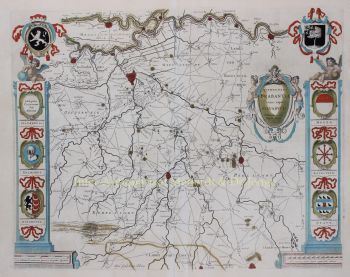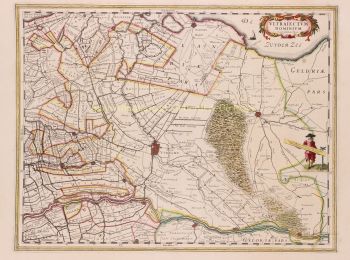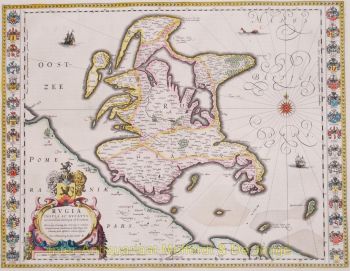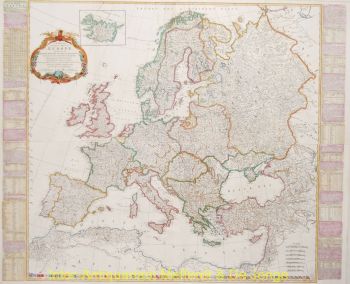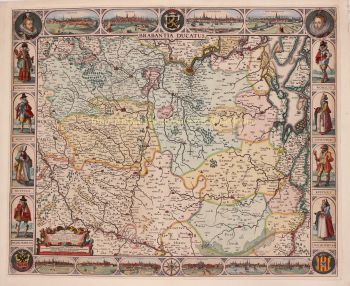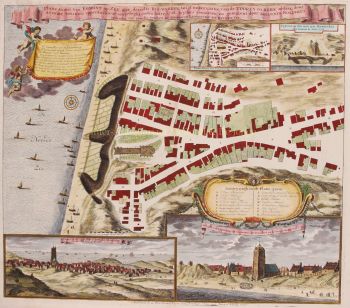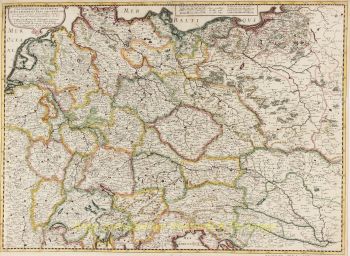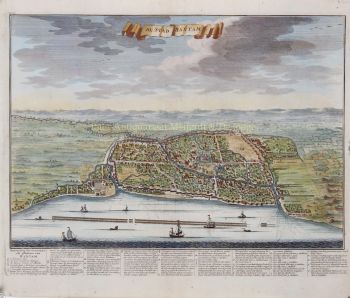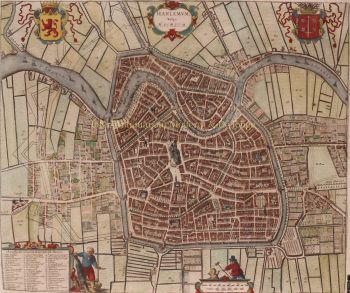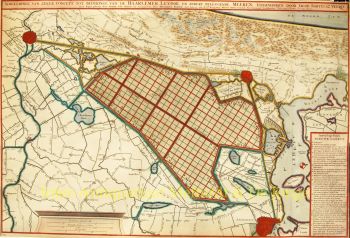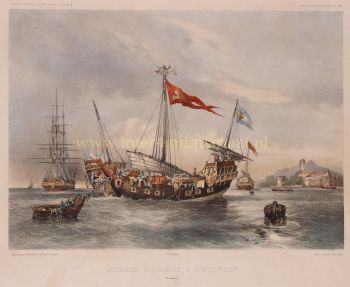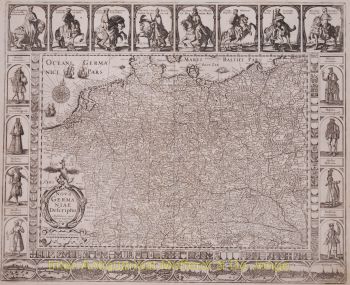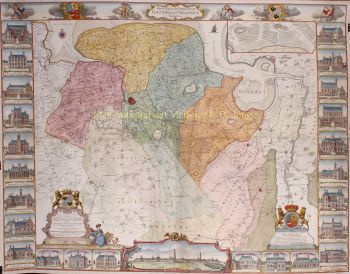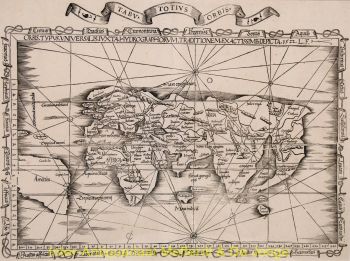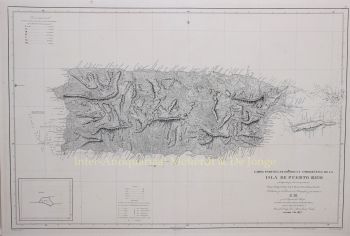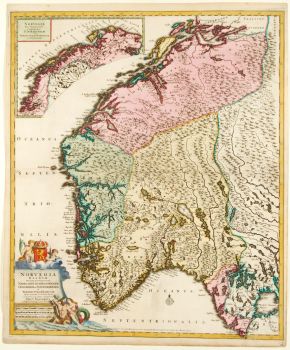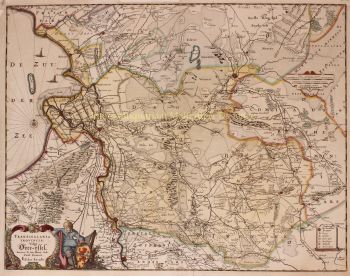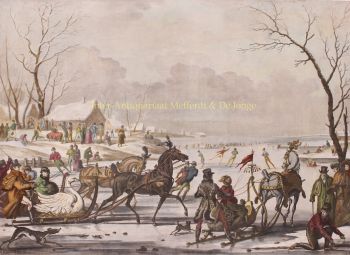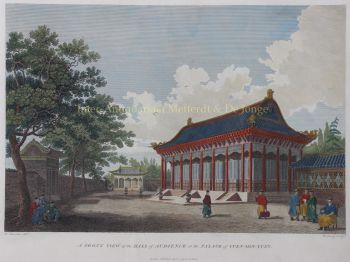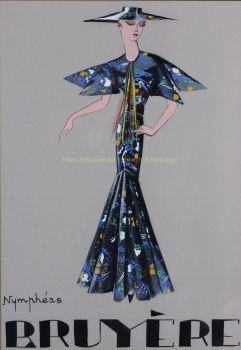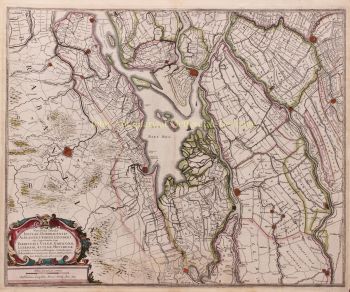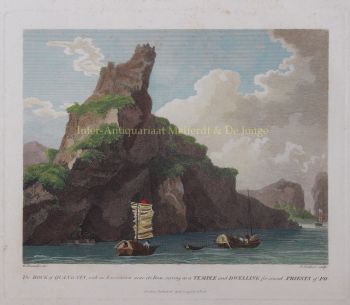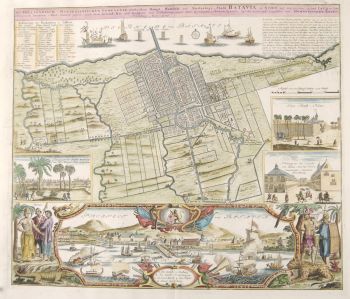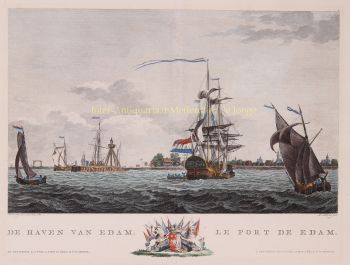Afrika 1640
Willem Janszoon Blaeu
€ 2.850
Inter-Antiquariaat Mefferdt & De Jonge
- Über KunstwerkAfricae nova descriptio Copper engraving with outline colour to cartographical image and full colour to pictorial borders. Published in Amsterdam by Willem Jansz. and Joan Blaeu c. 1640. Size: 41 x 55,5 cm. In handsome walnut frame. This is a cornerstone map of Africa and is one of the better known, more decorative maps of Africa of the seventeenth century. The map shows major African towns across the top: Tangiers, Ceuta, Algiers, Tunis, Alexandria, Cairo, the island of Mozambique, The Mine at St. George in Guinea and Canaria in the Canary Islands. The left and right borders show various indigenous costumes: Moroccans, Senegalese, traders in Guinea, Congolese, Egyptians, Abyssinians, Mozambicans, the king of Madagascar and inhabitants of Cape of Good Hope. The body of the map is richly embellished with animals, including elephants, monkeys, ostriches, gazelles, lions, cheetahs and camels. In the oceans are numerous sailing ships, sea monsters, flying fish, and a gorgeous compass rose. Much of the geographical information is still based on the Ptolemaic maps, with the Nile shown with its source in the Lakes Zaire and Zaflan. Also included are various other mythical lakes and rivers including the famous Lake Sachaf. Only coastal towns are named on the Cape, with the printing covering much of the unknown territory. Willem Janszoon, or Willem Jansz. Bleau (1571-1638) as he was to be later more commonly known, was one of the noted Dutch cartographers and map publishers of the seventeenth century. After preparation as a pupil of the great Danish astronomer Tycho Brahe, Bleau initially concentrated on globemaking and separately published maps, including wall maps of the continents. From 1608, he dominated the market for wall maps and sea atlases, and in 1630 produced his terrestrial atlas. These atlases were continued by his sons Joan (c. 1599-1673) and Cornelis (1610-1644), culminating in the great Atlas Maior of 1662 in 11 volumes by Joan Bleau with subsequent editions. On February 23, 1672 a fire at the offices of the Bleau publishing effectively ended the successful Bleau business. Joan died after the fire in 1673, and, though Joan II continued the business for some time, many of the plates were auctioned shortly thereafter. This map was not reprinted after 1672 as the Africa copperplate is not known to have survived the fire. The Spanish edition of the Atlas Maior was in the process of being printed, including the section on Africa with this map of Africa, when the fire occurred. Blaeu's maps set the standard for the quality of the engraving, paper and colour, as well as a fine depiction of contemporary geographical knowledge. Price: Euro 2.850,- (incl. frame)
- Über Künstler
„Willem Janszoon Blaeu und sein Sohn Joan verkörperten das ‚goldene Zeitalter‘ der niederländischen Kartographie. Willem Blaeu arbeitete im 17. Jahrhundert, zeichnete eine Reihe bahnbrechender Karten und veröffentlichte den ersten Atlas.
Er wurde 1571 in Amsterdam geboren und arbeitete zunächst als Angestellter im Heringshandel der Familie. Er war jedoch mit seinem Beruf nicht zufrieden und verließ 1594 seine Heimat, um bei Tycho Brahe, dem berühmten Astronomen, Mathematik zu studieren. Blaeu war ein guter Schüler, der seinen Lehrer sehr beeindruckte, und als er sein Studium beendet hatte, kehrte er nach Amsterdam zurück und gründete ein Unternehmen als Kartenhersteller. Sein Geschäft florierte und sein Ruf wuchs. Er war der erste Kartenhersteller, der Einzelblattkarten vieler europäischer Länder produzierte.
1605 fertigte er eine Wandkarte der Welt an, die 20 Blätter mit jeweils 8 Fuß Durchmesser umfasste. Diese Karte war bei weitem die genaueste der Zeit und leistete einen herausragenden Beitrag zur Kenntnis der Weltgeographie.
Seine Karte blieb bis 1648 die genaueste, als sein Sohn Joan, der auch ein berühmter Kartenzeichner wurde, sie aktualisierte. Aber seine größte Errungenschaft war die Erstellung des ersten Atlas im Jahr 1630. Der Name Blaeu war eigentlich ein Spitzname der Familie, den Willem annahm, nachdem es zwischen ihm und seinem großen Rivalen Joannes Jansonius zu Verwechslungen gekommen war.
Sind Sie daran interessiert, dieses Kunstwerk zu kaufen?
Artwork details
Related artworks
- 1 - 4 / 8
- 1 - 4 / 24
- 1 - 4 / 12



